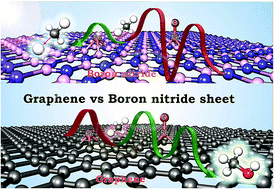Methane activation on Fe- and FeO-embedded graphene and boron nitride sheet: role of atomic defects in catalytic activities†
Abstract
Methane activation and direct oxidation to methanol on graphene (GP) and boron nitride sheet (BN) embedded Fe and FeO have been carefully studied by means of dispersion corrected DFT (PBE-D2). The strong orbital interactions between methane and the Fe active center through σ-donation and π-backdonation were found to facilitate the C–H bond dissociation. In the Fe-BN system, the π-backdonation is more dominant than that in the Fe-GP resulting in the facile C–H bond breaking with a lower energy barrier of 10.0 kcal mol−1, compared to that of 20.2 kcal mol−1. As a result, the methane C–H bond cleavage is kinetically and thermodynamically favorable on the Fe-BN system. For methane oxidation to methanol on FeO-BN compared to FeO-GP (results from RSC Adv., 2014, 4, 12572), the results reveal that the oxygen-center radical can activate the C–H bond in methane through a homolytic cleavage mechanism with reaction barriers of 20.9 kcal mol−1 and 17.5 kcal mol−1 for FeO-BN and FeO-GP, respectively. These barriers are comparable with reports on effective enzymatic systems. For methanol formation through the combination of methyl- and hydroxyl-grafted Fe-BN intermediate, the product derived from the C–H bond cleavage, required a very large energy barrier of 44.9 kcal mol−1, whereas in the Fe-GP system, the barrier was only 16.4 kcal mol−1 owing to its intermediate being less energetically stable. As a result, the conversion of methane to methanol over FeO-BN would be impeded by the incorrect stability of the intermediate. Overall, the supports play a significant role in the catalytic activity of Fe and FeO active sites for methane C–H bond cleavage and direct oxidation to methanol. This implies that the activity of the catalyst could be suitably designed by the selection of appropriate supports.


 Please wait while we load your content...
Please wait while we load your content...